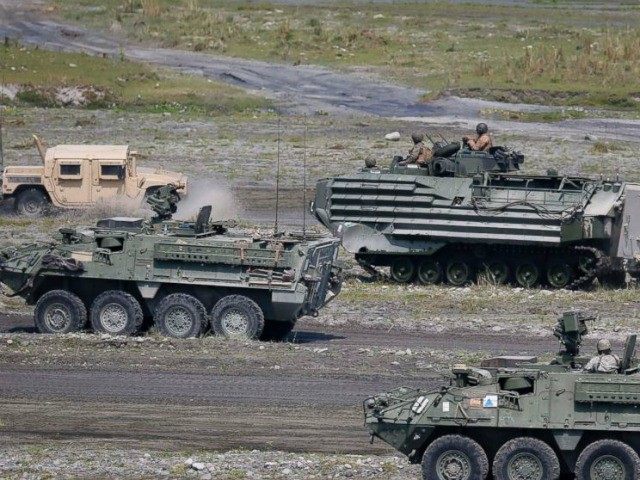The Pentagon has announced that American forces will conduct surveillance patrols with the Philippines “regularly” in the South China Sea, as Defense Secretary Ashton Carter concludes his trip to Manila to assert America’s commitment to protect the Philippines from Chinese expansionism in the region.
A Pentagon statement confirmed that U.S. troops will be rotated among five new American military bases in the Philippines, and joint operations will begin to occur regularly. Speaking from Manila, Carter expanded on this announcement, noting that the U.S. will be keeping almost 300 troops in the Philippines through April. The American military will also station warplanes in some of the five news bases it recently inaugurated in the Philippines, which greatly expands to that nation’s ability to defend maritime territories in the South China Sea.
Carter, speaking alongside his Filipino counterpart Voltaire Gazmin, made clear the intention of these activities, as well as the annual Balikatan exercises Carter was in the country to observe. They were also meant to make a display of solidarity with the Philippines and other nations in the region concerned that China has usurped sovereignty from them in the Spratly and Paracel Islands. “The stability and security of the Asia Pacific and the principles have helped so many in the region to rise and prosper,” The Philippine Star quotes Carter as saying Thursday. “And that’s not a new commitment. That’s not something new this year. But it’s one we have met decade after decade.”
“Countries across the Asia Pacific are voicing concerns with China’s land reclamation which stands out in size and scope, as well as militarization in the South China Sea. They are voicing these concerns publicly and privately … and we are answering that call,” Carter added. He emphasized that “from the American point of view, our alliance covers all of Philippine territory.”
Gazmin, the Philippine defense minister, expressed hope that a strong American presence in the Philippines would “deter uncalled-for actions by the Chinese in the region.” Satellite images published this week showed more warplanes and surface-to-air missiles being stationed on Woody Island of the Paracel Island chain, claimed by the Philippines and Vietnam, as well as China. Chinese ships have kept Philippine and Vietnamese fishermen out of their domestic waters near the Paracel Islands, sinking “intruding” ships with little question.
In addition to the Philippines and Vietnam, China’s claims in the South China Sea overlap with Brunei, Taiwan, and Malaysia’s. Carter sailed near the Spratly Islands on the USS Theodore Roosevelt in November with his Malaysian counterpart, Defense Minister Hishammuddin Hussein. The government of Indonesia has also expressed concern, as Indonesia’s Natuna Island straddles the border of the “nine-dash line” China uses to demarcate where it believes Chinese control ends in the sea. Indonesian authorities have also detained numerous Chinese vessels trespassing in Indonesian territory near Natuna.
The Chinese Foreign Ministry has reacted to the louder American push for containing Chinese colonization of the region with a terse statement accusing the United States of “promot[ing] the militarization of the region.” The more prominent military presence, according to the statement, is “the embodiment of Cold War thinking and not conducive to peace and stability in the South China Sea.”

COMMENTS
Please let us know if you're having issues with commenting.